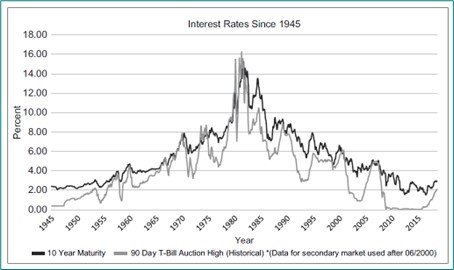Regardless of the type of image you will be writing alt text for, there are three key steps to the process: identifying the type of image, considering the purpose it serves within the text, and providing a description that will give equality in reading experience to all students.
Step 1: Identify the Type of Image
Be as specific as possible. If the image is a graph, what type of graph is it? It may be a line graph, a histogram, a scatterplot, a bar graph, or another type. If the image is a chart, what type of chart is it? It may be a pie chart, flow chart, diagram, timeline, pictograph, or another type.
Start your alt text by simply indicating the type of image.
Example 1: A Graph
Your book includes the following graph.

Source: Miles B. Livingston, Essentials of Money and Capital Markets: Fixed Income Markets and Institutions, 4th ed. (San Diego: Cognella, 2020), 3.
You begin your alt text:
A line graph.
Example 2: A Photograph
You book includes the following photograph.

Source: Copyright © 2020 Depositphotos/Krakenimages.com
You begin your alt text:
A photo.
Step 2: Consider the Purpose of the Image
Images can be provided for aesthetic purposes or educational purposes. This key distinction will guide the remainder of your alt text.
Photos are the most common type of image that would be provided for aesthetic purposes. For instance, a couple stock photos may be used in each chapter of an introductory-level textbook to keep students engaged.
Alternatively, some photos may be used for educational purposes. Graphs, charts, and other content-providing images are typically utilized for informational purposes; they would rarely be used for aesthetic purposes. When an image is included for educational purposes, the alt text likely needs to be a bit more in-depth and detailed, but you may also need to consider the specific purpose it serves.
For example, a graph or chart may be included simply to illustrate what a graph or chart is (for instance, in an introductory-level research text). In this case, you will want to focus on a description of the visual nature of the image.
Alternatively, if the graph or chart is used to demonstrate data or a concept touched on in the book, you will want to focus on the trends, actual numbers or text, organization, and other pertinent elements it displays.
For photos that are used for educational purposes, use context and caption clues to determine the exact purpose, then focus on creating a description of those elements. For instance, in a communications text, a photo may demonstrate body language and/or proper attire. In a history book, a photo may show an event or historical figure. In a biology book, a photo may show a piece of lab equipment or a class of animal.
With your purpose in mind, you can complete the alt text description.


